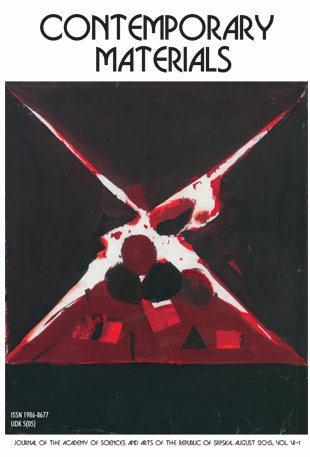FUZZY MODELING OF TEMPERING PROCESS OF CAST STEEL
DOI:
https://doi.org/10.7251/COMEN1702184JAbstract
Tempering is a heat treatment process to achieve maximum toughness and ductility at a specified hardness and strength. It is important to develop an intelligent model for tempering process to satisfy requirement of mechanical properties with low cost. This paper presents a fuzzy model to predict Charpy-V notch toughness during tempering process of steel. The influence of processing parameters of steel casting, hot working and heat treatment on toughness of tempered steel was investigated. Fuzzy model for prediction od Charpy-V notch toughness of steel was established. In order to validate the model, it is employed to predict the tempering of EN GS-42CrMo4 steel. The calculated results show a good agreement with the experimental ones. This agreement indicates that the fuzzy logic is effective for modeling of tempering process of steels.
References
P. Hodgson, R. Gibbs, A Mathematical Model to Predict the Mechanical Properties of Hot Rolled C-Mn and Microalloyed Steels. ISIJ international, Vol. 32−12 (1992) 1329−1338.
T. Inoue, K. Arimoto, Development and implementation of CAE system "HEARTS" for heat treatment simulation based on metallo-thermo-mechanics. Journal of Materials Engineering and Performance, Vol. 6−1 (1997) 51−60.
S. Denis, et al., Modelling of phase transformation kinetics in steels and coupling with heat treatment residual stress predictions. Le Journal de Physique IV, Vol. 9−PR9 (1999) Pr9-323-Pr9-332.
M. Lightfoot, et al., The application of artificial neural networks to weld-induced deformation in ship plate, Welding journal-New York-, Vol. 84−2 (2005) 23.
Kim, D. and S. Rhee, Optimization of a gas metal arc welding process using the desirability function and the genetic algorithm, Proceedings of the institution of mechanical engineers, part B: Journal of engineering manufacture, Vol. 218−1 (2004) 35−41.
Z. Bingul, G. E. Cook, A. M. Strauss, Application of fuzzy logic to spatial thermal control in fusion welding. IEEE Transactions on Industry Applications, Vol. 36−6 (2000) 1523−1530.
D. Dunne, H. Tsuei, Z. Sterjovski, Artificial neural networks for modelling of the impact toughness of steel, ISIJ international, Vol. 44−9 (2004) 1599−1607.
M. M. Adnan, et al., Fuzzy logic for modeling machining process: a review. Artificial Intelligence Review, Vol. 43−3 (2015) 345−379.
B. Smoljan, D. Iljkić, F. Traven, Mathematical modelling of mechanical properties of quenched and tempered steel. International Heat Treatment and Surface Engineering, Vol. 7−1 (2013) 16−22.
J. Campbell,, Castings, Butterworth-Heinemann, 2003.
P. Kovač, et al., Application of fuzzy logic and regression analysis for modeling surface roughness in face milling, Journal of Intelligent manufacturing, Vol. 24−4 (2013) 755−762.
W. Pedrycz, Fuzzy equalization in the construction of fuzzy sets, Fuzzy sets and systems, 2001. Vol. 119−2 (2001) 329−335.
